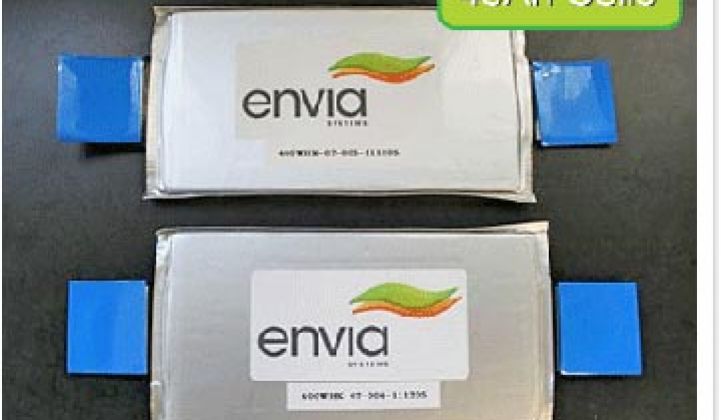The Golden Child of ARPA-E’s third annual Energy Innovation Summit is undoubtedly Envia Systems.
The lithium-ion energy storage company was mentioned by nearly everyone who took the stage on Tuesday. Most of the fanfare was around its recent announcement that the firm had achieved a world record 400 watt-hour/kilograms for a rechargeable lithium-ion cell.
The advancement is impressive for a car battery cell, when it’s compared with what is currently on the road. But like everything else at ARPA-E, the breakthrough is tempered by the fact that there is still serious work to be done before the battery joins its commercial-ready cousins.
"Rather than just a proof-of-concept of energy density, I am pleased that our team was successful in actually delivering 400 Wh/kg automotive grade 45 Ah lithium-ion rechargeable cells,” said Sujeet Kumar, Envia Systems co-founder, president & CTO.
The announcement was not to raise additional funding, but to show the automakers that its product had arrived. One automaker is already paying attention. General Motors lead a $17 million funding round last year. “OEMs knew this was coming,” said Atul Kapadia, CEO of Envia Systems, “they just didn’t know it was coming so soon.”
The Newark, Calif.-based company doesn’t make entire batteries. Instead, it has its own cathode, anode and electrolyte. The process of making entire batteries is extremely capital intensive, which is why the business is lead by giants like LG and Panasonic.
When Greentech Media asked Kapadia why the development was coming from a start-up of less than 40 people, rather than a large company, he pointed to the quality of the team they had, which is an interdisciplinary team of scientists that work well together and are focused on this one project, rather than having to work within a large corporation where not all the intellectual capital is concentrated in one lab. “It took five years of work on a simple process,” he said, “but with very complicated materials.”
Proving that its battery cell can perform at high levels, which could cut the cost of a 300-mile range electric vehicle by half, is just the first step. The next step is to integrate some of the components into the batteries that are currently going into EVs. Kapadia said that is expected to happen in 2014 or 2015.
Kapadia estimated it will take five to six years to get a full battery pack with the entire 400W/kg system. Eventually Envia could reach even higher energy densities, but probably not much higher because eventually there is a tradeoff with the car’s performance. Far higher energy densities would have to come from other materials besides lithium-ion.
Envia is now deciding where to go next. The company is inclined to go down a commoditization path because it will help move the market along faster.
The technology is further along than some other contenders for next generation EV batteries, but it is not the only player trying to move the market forward.
PolyPlus in Berkeley, Calif., another ARPA-E awardee, has come up with a solid electrolyte and other technologies that might make it possible to mass-manufacture lithium air batteries, a futuristic unit that could hold ten times as much power as today's batteries. The company also has a lithium sulfur battery it will license.
Lithium-air batteries are certainly further off from commercial availability than what Envia is working on, but PolyPlus is planning commercial production for its lithium water battery within two years, although a lithium-air commercial battery will likely take a decade.
GM and LG Chem are also licensing technology from Argonne National Laboratory, which developed a new cathode material with manganese that provides increased stability through a layered composite structure at a lower cost.
Pellion Technologies, which is backed by Khosla Ventures and ARPA-E is also using magnesium to up the energy density and drive down cost.
Envia is certainly out in front, but a walk around the Showcase floor at ARPA-E proves that there are a lot of other promising transportation energy storage technologies, including 10 funded by ARPA-E's BEEST program, which are hoping to be the next happy story of Energy Innovation Summit 2013.



